

Augmented Reality Brings New Dimensions to Learning. Editor's Note: Drew Minock, who co-wrote this piece, is an elementary teacher, co-founder of the popular education blog Two Guys and Some IPads, and is one of the voices on "The Two Guys Show" podcast.
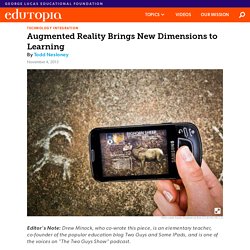
Imagine living in the magical world of Harry Potter, where the school hallways are lined with paintings that are alive and interactive. Now imagine creating an atmosphere like that for your students. Augmented Reality (AR) allows educators and students to do just that: unlock or create layers of digital information on top of the physical world that can be viewed through an Android or iOS device. Most people who interact with AR for the first time have a mind-blowing experience but fail to consider classroom applications. In our elementary school classrooms, we use AR to create active learning experiences hitherto inconceivable, and in the process redefine the learning space!
Classroom Applications Not Just Another Fad There are endless ideas and possibilities for using AR. Augmented and Virtual Reality. Ipad Educators. Augmented Reality in the Classroom. READ MORE RECENT BLOG POSTS ABOUT AUGMENTED REALITY HERE!
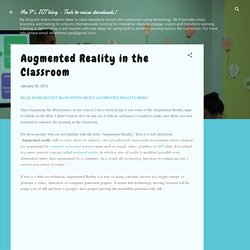
Since beginning the iPad journey in our school, I have been dying to use some of the Augmented Reality apps available on the iPad. I didn't want to dive in and use it with no substance I wanted to make sure there was real potential to enhance the learning in the classroom. For those people who are not familiar with the term "Augmented Reality," here is a web definition: "Augmented reality (AR) is a live, direct or indirect, view of a physical, real-world environment whose elements are augmented by computer-generated sensory input such as sound, video, graphics or GPS data. It is related to a more general concept called mediated reality, in which a view of reality is modified (possibly even diminished rather than augmented) by a computer. If that is a little too technical, Augmented Reality is a way of using a picture, known as a trigger image, to generate a video, slideshow or computer generated graphic.
20 Ways to Use Augmented Reality in Education. Second Life proved an incredibly valuable tool for educators hoping to reach a broad audience — or offering even more ways to learn for their own bands of students.
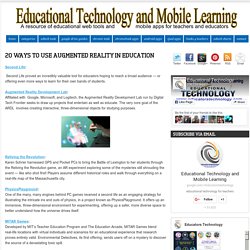
Augmented Reality Development Lab: Affiliated with Google, Microsoft, and Logitech, the Augmented Reality Development Lab run by Digital Tech Frontier seeks to draw up projects that entertain as well as educate. The very core goal of the ARDL involves creating interactive, three-dimensional objects for studying purposes. Reliving the Revolution: Karen Schrier harnessed GPS and Pocket PCs to bring the Battle of Lexington to her students through the Reliving the Revolution game, an AR experiment exploring some of the mysteries still shrouding the event — like who shot first!
Players assume different historical roles and walk through everything on a real-life map of the Massachusetts city. FETCH! Driver’s ed: Toyota teamed up with Saatchi & Saatchi to deliver the world’s cleanest and safest test-drive via augmented reality. 3 Free Virtual and Augmented Reality Apps for the Classroom. Virtual reality (VR) and augmented reality (AR) have never been more accessible for teachers and students.
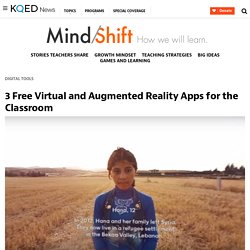
Of course, the technology isn’t perfect yet, and the content offerings can be hit or miss. But, considering how many students carry smartphones, and with cardboard-style VR viewers starting at about $15, it’s easier than ever to give kids immersive VR and AR experiences in class. In education, it’s easy to think of VR as more of a tool for training (think flight simulators), but the real learning potential lies more in its ability foster empathy in students.
Walking in someone else’s shoes has always been a valuable exercise, even if it’s a bit abstract for kids. VR has the potential to bridge this gap in ways it’s hard to do otherwise. Where VR brings the world into our classrooms, I think of AR as extending elements of our classrooms outward. How to Transform Your Classroom With Augmented Reality. Augmented Reality is changing education.
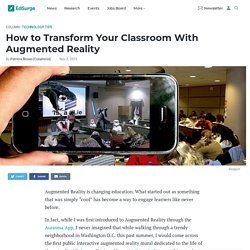
What started out as something that was simply “cool” has become a way to engage learners like never before. In fact, while I was first introduced to Augmented Reality through the Aurasma App, I never imagined that while walking through a trendy neighborhood in Washington D.C. this past summer, I would come across the first public interactive augmented reality mural dedicated to the life of the actor Paul Robeson. Designed by artist Corey L. Stowers, this mural allows viewers to scan and thus trigger images of his artwork with their mobile devices, accessing historical videos and original content that depict the life of the great athlete, performer, and civil rights activist. W3C Workshop: Augmented Reality on the Web, 15 - 16 June, Barcelona. Objectives.
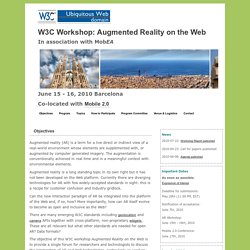
Google Expeditions Adds Augmented Reality for Classrooms. Augmented Reality Google Expeditions Adds Augmented Reality for Classrooms Image Credit: Google.

At Google’s annual developer conference this week, Google I/O 2017 (May 17-19), the company revealed plans to bring augmented reality (AR) to its immersive education platform Google Expeditions. The upcoming Expeditions AR mode harnesses Google’s Tango AR platform, which uses Visual Positioning Service (VPS) technology to map indoor locations. With a Tango-compatible device, such as the Lenovo Phab 2 Pro, the camera will utilize VPS to recognize specific objects and landmarks.
Expeditions AR lessons will be available to schools this fall through a Pioneer Program. Just two years ago at I/O, the company unveiled Google Expeditions for the 2015-16 school year as part of an effort to bring low-cost, virtual field trips to the classroom. To see how Expeditions AR could be used in the classroom, watch the video below.
About the Author.